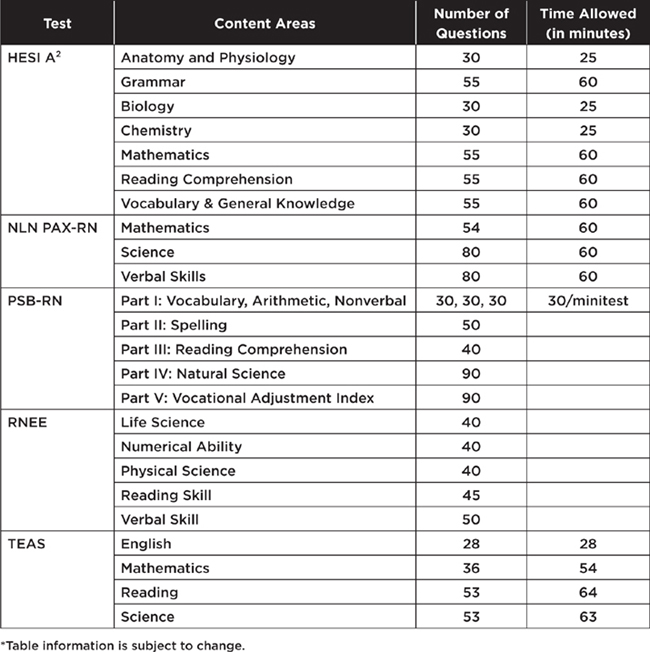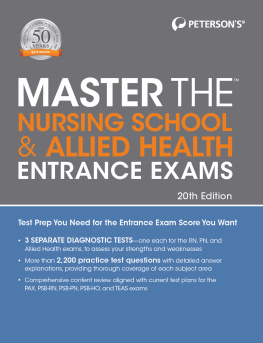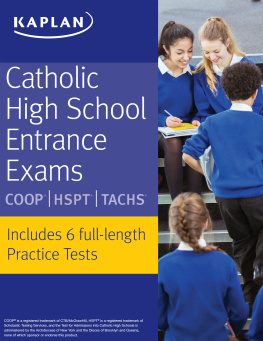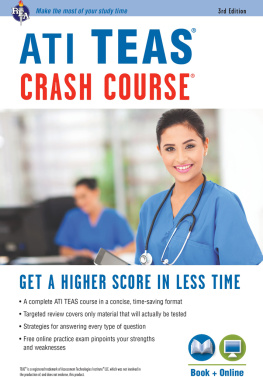Contents
Guide
Page List

Copyright 2020, 2016, 2011, 2007 by Kaplan, Inc., d/b/a Barrons Educational Series Previous editions Copyright 2004, 1998 by Kaplan, Inc., d/b/a Barrons Educational Series under the title
How to Prepare for the Nursing School Entrance Exams All rights reserved under International and Pan-American Copyright Conventions. By payment of the required fees, you have been granted the non-exclusive, non-transferable right to access and read the text of this eBook on screen. No part of this text may be reproduced, transmitted, downloaded, decompiled, reverse engineered, or stored in or introduced into any information storage and retrieval system, in any form or by any means, whether electronic or mechanical, now known or hereinafter invented, without the express written permission of the publisher. Published by Kaplan, Inc., d/b/a Barrons Educational Series 750 Third Avenue New York, NY 10017
www.barronseduc.com ISBN: 978-1-5062-6948-1 10 9 8 7 6 5 4 3 2 1
CONTENTS Are you wondering what might be included on a nursing school entrance exam, or does the nursing program youve applied to require an entrance exam? If you answered yes to either of these questions, then
Nursing School Entrance Exams is the reference you need. Nursing school entrance examinations provide associate, diploma, and baccalaureate nursing programs with specific information relating to an applicants or newly admitted individuals abilities in content areas that provide the foundation for nursing courses such as verbal ability, reading comprehension, numerical or mathematical ability, and life and/or physical sciences. Nursing school entrance examinations generally use a multiple-choice format.
Verbal ability includes elements such as vocabulary, antonyms, synonyms, verbal reasoning, and the use of analogy. Included in verbal ability are English usage and grammar, spelling, prefixes, suffixes, and root words. Reading comprehension involves reading sentences, paragraphs, or short articles and answering questions, interpreting, and/or making inferences about the literary material. Prior knowledge of the topic is not requisite for reading comprehension because the examination is asking you to think logically and make decisions based on the information presented. Topics for verbal ability and reading comprehension may address technical or scientific knowledge and/or general, everyday knowledge. Information may come from discipline-specific vocabulary, English grammar, history, geography, literature, art and architecture, humanities, general information, natural sciences, social sciences, and mathematics.
Numerical ability encompasses arithmetic, algebra, and geometry. Computation and interpretation of word problems, charts, ratios and proportions, decimals, percentages, and fractions may also be included. Word problems, drawn from common life events, may address such areas as sales, taxation, insurance, distance or travel, geometry, age, mixtures, investments, interest, and averages. Life and/or physical sciences sections focus on basic premises of biology, chemistry, human anatomy, and physiology. Life sciences specifically address human structure and functioning, development, and genetics. This book is intended to assist you to prepare or review for a nursing school entrance examination.
This book is not intended to provide sufficient instruction on any topic in which you have little or no previous experience. For example, if you have never taken algebra or geometry, it is doubtful that the algebra and geometry sections found in this book will provide a background that will enable you to be successful on similar sections of a nursing school entrance examination. Nursing School Entrance Exams is not intended to address a specific nursing school entrance examination. Nursing programs using entrance exams have a number of examinations from which to choose. These standardized exams are used nationwide. A brief overview of selected nursing school entrance examinations is presented in the following table: Overview of Selected Nursing School Entrance Examinations* So you think you want to be a nurse.
So you think you want to be a nurse.
Nursing is one of the most gratifying careers youll ever find. But nursing is not what youve seen on television or read about in books. Nursing is hard work, and learning to become a nurse requires dedication and long hours of study and preparation. Unlike many disciplines in which the academic curricula has foundation courses with many related subjected areas, nursing courses usually build on one another. Prerequisite courses, such as anatomy and physiology, chemistry, microbiology, and biology, are the foundation for what you will learn in your nursing courses, such as medical-surgical nursing, pharmacology, obstetric nursing, mental health nursing, and community health nursing. When enrolling in prerequisite courses, it should be with the intention of seriously learning information for use as your basic foundation in your nursing courses.
Weaknesses in your prerequisite courses may cause problems not only in your nursing coursework, but also on your nursing entrance exam. Remember, nursing courses depend heavily on knowledge learned in prerequisites. Todays nurses work in numerous roles and settings, and opportunities are virtually unlimited. The following list includes settings in which nurses may practice:
| Hospitals | Cruise ships |
| Clinics | Retirement/nursing homes |
| Doctors offices | Volunteer organizations |
| Business/industry | Occupational health programs |
| Community agencies | Ambulatory care agencies |
| Schools | Hospices |
| Nursing schools (higher education) | Federal/state agencies |
| Military | Home care |
| Resorts and summer camps |
What a nurse actually does depends upon the scope of the practice setting. In the majority of institutional or home health settings, nurses provide care to individuals with chronic, acute physical, and/or mental conditions. What a nurse does also depends upon the needs of the individual patient.
The nurse may assume total care of a patient who is unable to meet any of his or her needs or may help only in areas where assistance is needed. When working with patients, nurses assume a number of roles. In many cases, these roles overlap and are interdependent in nature. They include:
| Caregiver | Role model |
| Comforter | Decision maker |
| Advocate | Case manager |
| Teacher | Communicator |
| Counselor | Researcher |
When practicing in these various roles, the nurse works to meet, or helps the patient meet, hygiene, elimination, safety, nutritional, spiritual, comfort, activity, sensory, adaptation, and/or mental health needs. The nurse focuses on assessing, analyzing, planning, and resolving actual or potential health problems and evaluates the effectiveness of nursing interventions based on the patients responses. Most people think of nurses as working with individuals on a one-to-one basis.








 Copyright 2020, 2016, 2011, 2007 by Kaplan, Inc., d/b/a Barrons Educational Series Previous editions Copyright 2004, 1998 by Kaplan, Inc., d/b/a Barrons Educational Series under the title How to Prepare for the Nursing School Entrance Exams All rights reserved under International and Pan-American Copyright Conventions. By payment of the required fees, you have been granted the non-exclusive, non-transferable right to access and read the text of this eBook on screen. No part of this text may be reproduced, transmitted, downloaded, decompiled, reverse engineered, or stored in or introduced into any information storage and retrieval system, in any form or by any means, whether electronic or mechanical, now known or hereinafter invented, without the express written permission of the publisher. Published by Kaplan, Inc., d/b/a Barrons Educational Series 750 Third Avenue New York, NY 10017 www.barronseduc.com ISBN: 978-1-5062-6948-1 10 9 8 7 6 5 4 3 2 1 CONTENTS
Copyright 2020, 2016, 2011, 2007 by Kaplan, Inc., d/b/a Barrons Educational Series Previous editions Copyright 2004, 1998 by Kaplan, Inc., d/b/a Barrons Educational Series under the title How to Prepare for the Nursing School Entrance Exams All rights reserved under International and Pan-American Copyright Conventions. By payment of the required fees, you have been granted the non-exclusive, non-transferable right to access and read the text of this eBook on screen. No part of this text may be reproduced, transmitted, downloaded, decompiled, reverse engineered, or stored in or introduced into any information storage and retrieval system, in any form or by any means, whether electronic or mechanical, now known or hereinafter invented, without the express written permission of the publisher. Published by Kaplan, Inc., d/b/a Barrons Educational Series 750 Third Avenue New York, NY 10017 www.barronseduc.com ISBN: 978-1-5062-6948-1 10 9 8 7 6 5 4 3 2 1 CONTENTS So you think you want to be a nurse.
So you think you want to be a nurse.